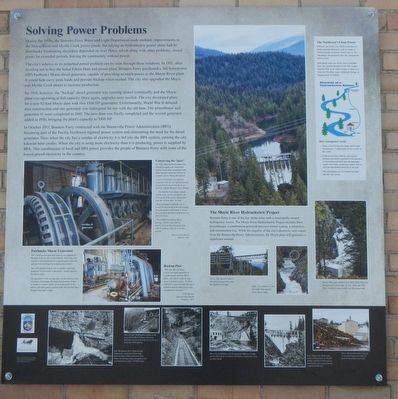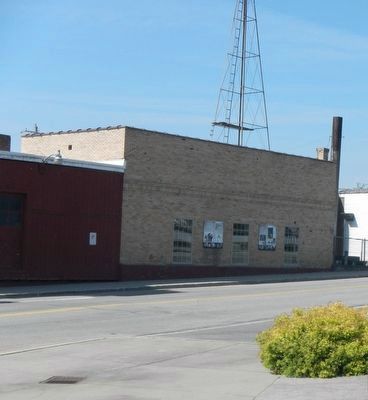Bonners Ferry in Boundary County, Idaho — The American West (Mountains)
Solving Power Problems

Photographed By Barry Swackhamer, May 8, 2018
1. Solving Power Problems Marker
Captions: (center) The Movie Project's substation, power lines and the Highway 2 bridge.; (middle right) The abutment of the old coffer dam remains above Moyier Falls. (upper right) The powerhouses were built about 1000 feet downstream from the dam in 1921, 1941, one 1983. Their combined output totals over four megawatts. (The text for the photos on the bottom row at not legible.)
During the 1920s, the Bonners Ferry Water and Light Department made multiple improvements to the Moyie River and Myrtle Creek power plants, but relying on hydroelectric power alone has its drawbacks. Generating electricity depended on river flows, which along with other problems, closed plants for extended periods, leaving the community without power.
The city's solution to its perpetual power problem can be seen through these windows. In 1931, after deciding not to buy the failed Eileen Dam and power plant, Bonners Ferry purchased a 360 horsepower (HP) Fairbanks Morse diesel generator, capable of providing as much power as the Moyie River plant. It would help carry peak loads and provide backup when needed. The city also upgraded the Movie and Myrtle Creek plants to increase production.
By 1938, however, the "backup" diesel generator was running almost continually, and the Moyie plant was operating at full capacity. Once again, upgrades were needed. The city developed plans for a new 92-foot Moyie dame with two 1500 HP generators. Unfortunately World War II delayed dam construction and one generator was redesigned for use with the old dam. The powerhouse and generator #1 were completed in 1941. The new dam was finally completed and the second generator added in 1950, bringing the plant's capacity to 3000 HP.
In October 1953, Bonners Ferry contracted with the Booneville Power Administration (BPA), becoming part of the Pacific Northwest regional power system and eliminating the need for the diesel generator. Now, when the city has a surplus of electricity it is fed into the BPA system, earning the city kilowatt hour credits. When the city is using more electricity than it is producing, power is supplied by BPA. This combination of local and BPA power provides the people of Bonners Ferry with some of the lowest-priced electricity in the country.
The Moyie River Hydroelectric Project
Bonners Ferry is one of the few Idaho cities with a municipally-owned hydropower source. The Movie River Hydroelectric Project includes three powerhouses, a combination penstock/pressure tunnel system, a substation and transmission lines. While the majority of the city's electricity now come from the Bonneville Power Administration, the Moyie plants still generates a significant amount.
(beside photos at middle left:)
Fairbanks Morse Generator
The 51,000-pound generator (above) was shipped to Bonners Ferry by rail car from Beloit, Wisconsin. On arrival, it was transferred to a concrete pad on this site, and the brick building was constructed around it.
The 1925 Model 32 Style VA, 6 cylinder, generator produced 230
kilowatts of electricity -- nearly equal to the Moyie plant.
The generator's only moving parts are the pistons, rods and oil pumps, fuel pumps, flywheel and governor. It has no intake or exhaust valves, air is compressed by the pistons and burnt gases expelled under the concrete floor, through large pipes (right).
Conserving the "juice"
In 1929, when the Moyie plant was closed for repairs, the remodeled Myrtle Creek plant carried the load. H.M. Buroker asked the citizens to conserve power during this period.
Users of electricity are asked to cooperate with the city light and power department in conserving the juice." Buroker told the Bonners Ferry Herald.
"...The Myrtle Creek plant, a much smaller unit.... will be enough for all local needs if the load is distributed for the 24-hour day." he said.
"Early morning or daylight use of power for household work will equalize the consumption operation of all motors in Bonners Ferry.
"The Saddler sawmill at Moyie Springs, which is operated by electricity from the municipal plant, will close down today for a 30-day period." -- Bonner Ferry Herald , August 8, 1929
Backup Plan
"The new (diesel) plant can be operated separately or synchronously with the Moyie plant, and will be ready to start up at a moment's notice. It will be available at any time that the city is asked to furnish additional power to industrial concerns." -- H.M. Buroker, Bonners Ferry Herald October 1, 1931
(side-bar at upper right:)
RoR plants make use of the river's available flow and natural elevation drops. This system requires little or no water storage so there is no reservoir flooding, major landscape change, or displacement of wildlife.
1 Water is diverted into the intake and through the penstock. A control gate can let in more or less water.
2 In the powerhouse, flowing water powers turbines with shafts connected to the generator. As the turbines and shafts spin, the generator's copper coils rotate, producing a steady flow of electrons and adding electricity to the grid.
3 The water passes into the tailrace and back into the river system.
Erected by Boundary County Historical Society, The International Selkirk Loop.
Topics. This historical marker is listed in these topic lists: Charity & Public Work • Industry & Commerce • Waterways & Vessels.
Location. 48° 41.869′ N, 116° 18.759′ W. Marker is in Bonners Ferry, Idaho, in Boundary County. Marker is on Riverside Drive near Main Street. Touch for map. Marker is at or near this postal address: 6424 Riverside Drive, Bonners Ferry ID 83805, United States of America. Touch for directions.
Other nearby markers. At least 8 other markers are within walking distance of this marker. Electrifying Bonners Ferry (here, next to this marker); Pelton Wheel (within shouting distance of this marker); Crossing the Kootenai (within shouting distance of this marker); Logging Railroads (about 300 feet away, measured in a direct line); Railroad Services (about 300 feet away); Railroad Laborers (about 300 feet away); Spokane International Railway (about 300 feet away); Kootenai Valley Railway (about 300 feet away). Touch for a list and map of all markers in Bonners Ferry.
More about this marker. This marker is on the side of the old power plant building.
Credits. This page was last revised on August 24, 2020. It was originally submitted on August 30, 2018, by Barry Swackhamer of Brentwood, California. This page has been viewed 173 times since then and 15 times this year. Photos: 1, 2. submitted on August 30, 2018, by Barry Swackhamer of Brentwood, California.
